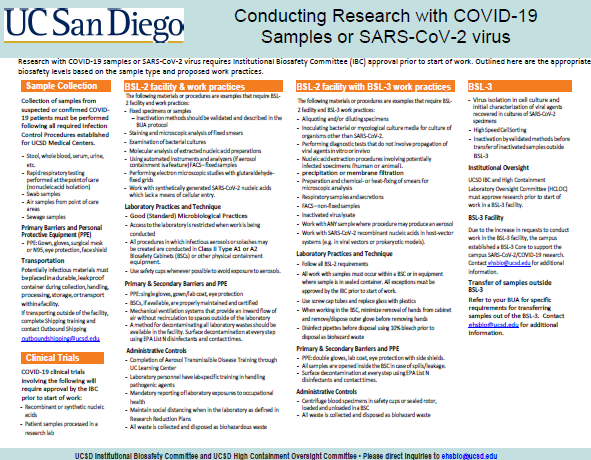COVID-19: Laboratory Requirements and Resources
Learn about lab requirements and guidance due to the COVID-19 pandemic.
Find information on how to safely decontaminate laboratory spaces, requirements for returning to work in your lab, biosafety containment requirements, PPE and more.
Laboratory Decontamination for Research Labs
Biosafety Level Determination
All research involving samples known or suspected to contain SARS-CoV-2 must be approved by the IBC prior to start of research.
The Institutional Biosafety Committee (IBC) has final determination on the biosafety level based on a risk assessment of the proposed work with COVID-19 materials. This information provides guidance to you on what may be the appropriate biosafety level for research you propose to the IBC.
(click to open)
BSL-2
Work which may require BSL-2 facilities and BSL-2 work practices includes but is not limited to, handling of fixed or inactivated clinical samples from COVID-19 patients and molecular analysis of extracted nucleic acid preparations. Depending on the material and procedures that will be performed with the material, the IBC may require one or more BSL-2+ additional safety precautions.
BSL-2+ work [BSL-2 Facility and BSL-3 Work Practices]
Work which may require BSL-2 facilities with BSL-3 work practices includes but is not limited to, processing of certain clinical samples from COVID-19 patients, performing diagnostic tests which do not involve propagation of the virus, and work with any sample where procedures may produce an aerosol.
Depending on the material and procedures that will be performed with the material, the IBC may require the following BSL-2+ additional safety precautions:
- All work must be performed in a biosafety cabinet.
- Sealed safety cups or sealed rotors must be used when centrifuging outside of the biosafety cabinet.
- Sealed samples must be wiped with disinfectant upon removing them from the biosafety cabinet for transfer. Exterior gloves should be changed after working in the biosafety cabinet.
- All sharps must have engineered protection devices or provide a written response as to why this cannot be accomplished in the BUA for IBC to review and approve. The IBC will review exceptions on a case by case basis.
- No glass is to be used without an exception granted by the IBC.
- Double gloves must be worn; the exception being that if this prevents needed dexterity, then a single layer of nitrile gloves can be used. This exception must be approved by the IBC.
- When using double gloves, the interior glove must be taped (use lab tape, masking tape, painters tape) to the laboratory coat to prevent bare skin exposure.
- No eating or drinking is allowed in laboratory areas where this agent is handled.
- All researchers must wash their hands with soap and water immediately after removing gloves. Regular and strenuous surface disinfection is required.
BSL-3 work
Important: Any work which involves the isolation of or characterization of SARS-CoV-2, the virus which causes the disease COVID-19, must be performed at BSL-3. Contact ehsbio@ucsd.edu for information regarding conducting research at BSL-3.
Additional requirements may include the following:
Medical surveillance may be required for employees who:
- Work in a BSL-3 facility
- Enter a BSL-3 or 2+ facility while BSL-3 or 2+ agents are being actively manipulated
Personal Protective Equipment (PPE)
- Your laboratory may be required to enroll in the Campus Respiratory Protection Program.
- PPE Services (laundry, virtual lab coat fittings, etc.)
Hazardous Waste Pickups
Please email hazwaste@ucsd.edu if you have any questions or concerns.
